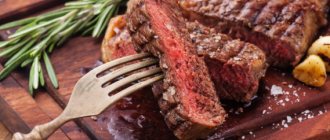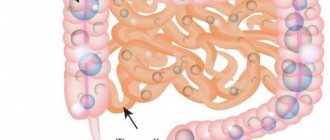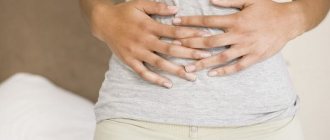The text is for informational purposes only. We strongly urge you not to use diets, resort to any therapeutic menus or fasting without medical supervision. We recommend reading: “Why can’t you go on a diet on your own?”
A diet for flatulence is a specific organization of a person’s diet, which is aimed at reducing gas formation in the intestines. The diet should ensure a complete supply of all the substances it needs to the body, help normalize intestinal motility, and reduce the processes of putrefaction and fermentation in it. The result of following the diet is the restoration of normal intestinal microflora and the elimination of conditions such as flatulence.
If we refer to the classification of treatment tables according to Pevzner, then in case of flatulence it is recommended to stick to table number five. However, drawing up any diet requires an individual approach and the exclusion of foods that a particular patient cannot tolerate. The energy value of the daily diet for flatulence is slightly reduced and amounts to 1600 kcal.
Principles of nutrition for flatulence
The principles of nutrition for flatulence are mandatory. Otherwise, the diet will not bring the expected benefits.
- Rules for eating
- Any quick snacks are strictly prohibited. Even if a person intends to eat any fruit, he must do so in a calm environment, chewing the food thoroughly. You should not carry on a conversation while eating. In this way, aerophagia will be eliminated, and the load on the gastrointestinal tract will be lower.
- You should not drink any liquid during meals.
- Approaches to the table must be made at the same time. This will enable the gastrointestinal tract to “remember” the hours of food intake and prepare for the process of its digestion and assimilation. Gastric juice, digestive enzymes, and bile acids will be released in a timely manner.
- Chewing gum for flatulence is prohibited. This is due to aerophagia during chewing and an unnecessary increase in gastric juice.
- Diet. It is necessary to stick to fractionation - eat in small portions, but up to 6 times a day. With this approach, beneficial substances will be broken down and absorbed in the intestines, and everything else will be quickly eliminated, without leading to putrefactive processes.
- Temperature of food consumed. Avoid eating excessively hot or excessively cold foods. Food should be warm. In this way, it will be possible to avoid excess production of stomach juices, which contributes to intestinal irritation.
- Food compatibility. Do not forget that there are products that are mutually exclusive. For example, milk and rough plant foods, sweet and salty dishes. If you do not adhere to the principle of food compatibility, then it will be much more difficult for the intestines to cope with the food bolus that enters it, which means that the risk of starting fermentation processes increases.
- Food processing. Products recommended for flatulence should be steamed, baked, boiled, or stewed. In this way, the principle of sparing the gastrointestinal tract will be observed.
- Drinking regimen and salt intake. Salt can have an irritating effect on the stomach and intestines, so its use is somewhat limited. You should not exceed the recommended dose of 8 g. As for the volume of fluid consumed, you should drink at least 2000 ml of water per day.
Consequences of not following the diet
If the diet is neglected, flatulence becomes a constant companion of a person, which means that the normal intestinal microflora dies, and fermentative and putrefactive bacteria begin to become active, which release toxins in the process of vital activity.
Toxins, in turn, are absorbed into the blood and negatively affect not only the organs of the digestive tract (for example, the liver), but also the entire body.
A lack of healthy microflora will lead to hypovitaminosis, since many vitamins are synthesized by normal intestinal microorganisms (vitamin K, B vitamins).
What should you not eat if you have flatulence?
The list of prohibited products is quite extensive. First of all, these are all the foods that contribute to increased gas formation.
There are three such product groups:
- Products that contain coarse, indigestible fiber. Once in the intestines, such a bolus of food promotes the growth of microflora. Accordingly, during their life processes they will release more gases, which will lead to flatulence.
- Foods that contain simple carbohydrates. On the contrary, they break down very quickly in the intestines and provoke rotting processes.
- Products to which the patient has an individual intolerance. Most often, people are diagnosed with lactose deficiency, so whole milk and all products containing it must be removed from the menu.
Protein foods will contribute to the development of decay processes, since they are quickly broken down in the intestines. Unnecessary intestinal irritants include preservatives, food additives, essential oils, and organic acids.
So, here's what you can't eat if you have flatulence:
- Fresh baked goods;
- Millet bread, rye bread;
- Baked pies;
- Pasta;
- Dumplings and dumplings;
- Any fatty meat, including poultry and fish;
- Any stringy meat;
- Fatty broths;
- Pickles and marinades, even homemade ones, herbs, sauces;
- Any canned food;
- Salted fish, caviar;
- Lard, corned beef;
- Smoked products;
- Mushrooms, cooked in any form;
- Some cereals: pearl barley, millet, barley;
- Products containing animal fat: milk, full-fat sour cream, cream;
- Any representatives of legumes: peas, lentils, chickpeas, beans and dishes based on them;
- Any cabbage, raw onion, radish, daikon, radish, rutabaga;
- Raisins and prunes;
- Some fruits: melons, grapes, pears, apples, peaches, bananas;
- Nuts;
- Coffee, cocoa with milk;
- Drinks containing gases (except for specialized mineral waters on the advice of a doctor);
- Beer, kvass, kumiss;
- Chocolate, honey, jam;
- Potatoes and other products containing large amounts of starch;
- Soy products (soy milk, tofu);
- Eggs fried and boiled until fully cooked.
Causes
Constipation and bloating may be associated with disruptions to your usual diet. Eating mechanically gentle, high-calorie foods, lack of fiber, and eating foods with an astringent and fixing effect are the main causes of unpleasant symptoms of intestinal dysfunction.
The list of such products includes strong tea, coffee, cottage cheese, boiled rice, pears, pomegranate, pomegranate juice, quince, flour, chocolate.
There are also less common groups of causes of stool retention combined with bloating:
- lifestyle features: lack of exercise, forced bed rest, sedentary work;
- endocrine and metabolic disorders;
- neurological factors;
- psychogenic causes;
- gastroenterological diseases;
- proctological diseases.
Shulpekova and Ivashkin indicate in their work that “among the causes of chronic constipation in the age group under 20 years, the anatomical features of the colon dominate; at the age of 20–40 years - pathology of the anorectal zone; after 40 years, psychogenic, neurogenic, endocrine, gastroenterological causes of constipation and causes associated with pathology of the anorectal zone are equally common” (Shulpekova Yu. O., Ivashkin V. T., 2004, p. 49).
Among the endocrinological diseases accompanied by constipation, the most common are hypothyroidism and diabetes mellitus. Lack of thyroid hormones and hypercalcemia reduce the tone of the intestinal muscles. The result is atonic constipation.
Today, the mechanisms of development of functional constipation and bloating in irritable bowel syndrome are being actively studied. They also consist of disturbances in the peristaltic activity of the intestinal walls. In this case, we are talking about spastic constipation, in which feces and gases are retained in a certain spasmodic area.
Pain during bowel movements associated with thrombosis of hemorrhoids or anal fissure becomes an additional factor in the development of stool retention.
Also, the cause of bloating and delayed bowel movements can be medications, the side effects of which include these symptoms.
What can you eat if you have flatulence?
Products that are allowed for flatulence are those that do not irritate the intestines, do not stimulate gas formation and do not have a carminative effect. A bolus of food entering the intestines must pass slowly and gently through it, without lingering or interfering with the processes of rotting and fermentation.
It is important to include in your meals those foods that promote the growth of normal microflora and are rich in iron, potassium, calcium and vitamins.
So, here's what you can eat if you have flatulence:
- Rusks made from wheat flour;
- Rye bran;
- Day-old bread or dried bread;
- Soufflés, meatballs, cutlets, meatballs made from lean animal meat (veal, rabbit) and poultry (cooking method: steam), skin must be removed;
- Seafood, low-fat boiled fish;
- Meat and fish broths;
- Fish and meat pates;
- Cottage cheese soufflé, low-fat biokefir, yogurt, yogurt and low-fat sour cream (if there is no lactose intolerance);
- Limited: potatoes, beets, carrots, zucchini, pumpkin;
- Parsley, dill, you can prepare dill water;
- Cumin and bay leaf are allowed as seasonings;
- Cereal porridges cooked in water: oatmeal, semolina, rice and buckwheat;
- Soft-boiled eggs, steamed egg white omelette;
- Green tea, cocoa in water, decoction of rose hips, blueberries, bird cherry, compotes, diluted juices.
In fact, the menu for flatulence only at first glance seems too strict. However, from a set of permitted products, you can prepare a considerable number of tasty and healthy dishes, against which the intestines will not rebel.
What examinations need to be performed?
Due to the numerous causes of flatulence, it is difficult to immediately determine a diagnostic method to identify the source of the problem. The patient’s initial visit takes place at an appointment with a local therapist, who will give a referral for further examination by a gastroenterologist. Most of the patients who complained of gas accumulation had gastrointestinal disorders.
The list of necessary examinations includes:
- After a visual examination and palpation of the swellings, the patient is referred for colonoscopy and endoscopy. Having received the main indicators, a biopsy is taken from the stomach to study the problem in more detail.
- An ultrasound of the abdominal cavity allows you to see a full picture of what is happening, possible deviations, the condition of the organs, the presence of a cyst. If necessary, the doctor conducts an additional ultrasound examination of the liver, stomach, and pancreas.
- Examination of the abdominal cavity using an X-ray machine. The walls of the large and small intestines are visible.
- Passing pH measurements to identify disorders of gastric secretions.
- Blood and stool tests, which are given and examined in the laboratory.
Sample menu for flatulence
An approximate menu for flatulence may look like this:
| Breakfast | Lunch | Dinner | Afternoon snack | Dinner | |
| First option | Oatmeal. Cocoa on water. | Yesterday's bread with homemade fish pate or vegetable caviar. | Hake soup, chicken tenders with vegetable stew. Compote. | Baked apple. Ryazhenka. | Casserole with cottage cheese. Stewed chicken gizzards with rice. Green tea. |
| Second option | Cottage cheese pancakes, semolina porridge. Green tea. | A cheese sandwich. | Vegetable soup. Rabbit meatballs with buckwheat. Rose hip decoction. | Soft-boiled egg. Kefir. | Casserole with potatoes and fish. Steamed zucchini pancakes. Compote. |
Symptoms
Symptoms of bloating and constipation are quite common. Constipation is said to occur when at least two of the following symptoms have been observed within the last 12 weeks:
- two bowel movements per week or less;
- the need for straining when it takes more than 1/3 of the time of bowel movement;
- dense consistency of stool;
- feeling of blockage, foreign body in the rectum, incomplete evacuation.
Bloating manifests itself in a characteristic pattern: the abdomen noticeably increases in volume. It is often accompanied by paroxysmal or constant pain, a feeling of fullness and pressure. The localization of pain is determined by where in the intestine gases have accumulated.
Constipation is often accompanied by headaches, dizziness, nausea, decreased appetite, and increased fatigue. This is caused by general intoxication of the body due to fecal retention.
Some symptoms of disorders may be associated with self-medication. Many people strive to get rid of unpleasant symptoms - they take painkillers and antispasmodics to eliminate pain. Antispasmodics in large quantities help relax muscles, and with intestinal atony this can aggravate the problem. If the cause of constipation and bloating is unknown, it is better to avoid self-medication.
Uncontrolled use of stimulant laxatives and frequent cleansing enemas can cause complications in the form of addiction. In this case, a symptom may be the absence of one’s own stool, manifestations of dysbacteriosis and other disorders.
Long-term constipation becomes a source of chronic intoxication. Against this background, dermatological and allergic diseases may develop, weakening of defenses, and chronic pathologies may worsen. People with constipation may experience skin rashes, an unhealthy, gray complexion, and weight loss due to lack of appetite.
Products that cause flatulence
There are foods that cause flatulence when consumed, even in people who do not have problems with the gastrointestinal tract, these are:
- Any fresh baked goods, especially black bread and yeast baked goods;
- Raw vegetables containing coarse fiber and extractive substances: cabbage, radish, onions and garlic, turnips, radishes, spinach;
- Fatty fish, meat, poultry;
- Fried foods;
- All legumes;
- Hard-boiled eggs;
- Any smoked dishes;
- Nuts;
- Pearl barley and millet;
- Sugar and its substitutes;
- Whole milk, heavy cream, ice cream;
- Sweet raw fruits: grapes, bananas, apples;
- Any carbonated drinks: sweet water, kvass, beer.
In addition, exotic cuisine can increase gas formation, as the human digestive system gets used to the breakdown of foods that he eats daily. In this regard, unusual fruits that do not grow in their native climate zone can pose a danger. For example, for Russians, these are pineapples, avocados, kiwis, grapefruits and other exotics.
How to remove gases at home
Eliminating symptoms involves getting rid of pain and eliminating it naturally. If gas formation occurs as a result of air entering the stomach, then measures should be taken to prevent its penetration into the gastrointestinal tract when eating.
Exercises
Therapeutic gymnastics helps to easily get rid of the problem, it is simple and effective. You need to do exercises regularly - this will improve the functions of the lower gastrointestinal tract, because blood circulation in the stomach area will increase. You can perform gymnastic exercises at home. They all start from a supine position. So, we get rid of the accumulation of gases in the intestines by performing physical exercises:
- Starting position – with knees bent and lying down, perform the bicycle exercise. Make at least 30 circles with your legs.
- In the same starting position, pull your legs bent at the knees towards your stomach. Return to original position. Do it 10 times.
- Raise your legs and throw them behind your head. Perform 15 times.
- Bend your legs, spread and connect your knees. Do 15 times.
- Starting position: kneeling, keep your back parallel to the surface. Raise your left leg, then your right. Perform 10 times with each leg.
- The position is the same: exhale - bend down at the waist and hold for a moment and take in air again. On a new exhalation, bend your spine upward and tighten your stomach. Do 30 times.
What and how can we help you?
- Consult with a competent specialist - our gastroenterologist will examine you in detail, if necessary, prescribe additional consultations with related specialists and monitor the treatment process, from the first visit to the result.
- To identify the cause of constipation - we have all the necessary expert-class equipment and highly qualified diagnostic specialists to conduct a detailed examination - tests, ultrasound, endoscopic examinations.
- Save you time and money - to find out why your intestines are refusing to work regularly, we have created a free conversation with a gastroenterologist to schedule an examination. If you are concerned about your symptoms, but you don’t know where to start, during the conversation you will be prescribed the necessary range of tests.
Constipation is the cause and consequence of many diseases. A competent doctor will help you understand them. You shouldn’t prescribe laxatives to yourself, get carried away with enemas, or delay visiting a gastroenterologist. You may miss something important and waste valuable time. Don't take risks - contact a specialist.
In conclusion, here are a few interesting clinical cases from our practice:
Constipation and... thyroid: where is the connection?
A young girl, 23 years old, contacted us. It turned out that she had been suffering from constipation for 1.5 years! Our doctor carefully interviewed the patient and found out that during pregnancy, 3 years ago, she was diagnosed with a dysfunction of the thyroid gland, but nothing bothered her and no treatment was carried out.
We examined her more thoroughly and found out that the cause of constipation was autoimmune thyroiditis - a common situation in women, when the body “attacks” its own thyroid gland, it is gradually destroyed and the level of hormones drops. One of the symptoms of autoimmune thyroiditis is constipation. Our endocrinologist prescribed treatment, the function of the thyroid gland returned to normal, and joint work with a gastroenterologist yielded results - the constipation went away.
Constipation and something else
A 67-year-old patient came to us with complaints of constipation. Laxatives didn't help. The doctor examined him, but found no significant abnormalities. However, the age and nature of the complaints were alarming, and the patient was sent for a detailed examination.
A blood test revealed a decrease in hemoglobin, an increase in ESR, and occult blood in the stool using the ultrasensitive Colon View test for occult blood in the stool. We performed a colonoscopy, an examination of the intestines using a flexible endoscope, and identified an intestinal tumor. Luckily, we made it on time.
The patient was successfully operated on and is under the supervision of a gastroenterologist and oncologist.
Medicines
Dyspepsia, abdominal pain, constipation or diarrhea are characteristic signs of increased gas production. If they are very pronounced, then drug treatment cannot be avoided. Gases come out faster after a course of taking pharmacological drugs from the following groups:
- eubiotics that restore the optimal composition of the intestinal microflora - Linex, Bifidumbacterin, Lactobacterin, Enterol, Acipol;
- defoamers that collapse gas bubbles - Espumisan, Bobotik, Sub-simplex;
- enterosorbents that bind and evacuate toxic substances - activated carbon, Smecta, Polysorb;
- digestive enzymes that qualitatively break down food products - Festal, Mezim forte, Enzistal, Panzinorm.
The signs of excess gas formation can be removed by taking prokinetics: Motilium, Passazhix, Domperidone, Metoclopramide, Motilac. This group includes drugs that promote the movement of food through the digestive tract, effectively eliminating nausea, vomiting, diarrhea, and constipation.
Multicomponent infusions
Combined infusions cope well with the symptoms of flatulence, which often become the causes of poor health, pain and discomfort. With their help, it is possible to get rid of problematic gases with an unpleasant odor. As well as a feeling of fullness in the stomach after eating a small amount of food.
| Infusion for the treatment of flatulence | Preparation and dosage regimen |
| Antispasmodic | Pour 4 tbsp into a thermos. l. mint, dandelion, thyme, pour 2 cups of boiling water, filter after 3 hours and take 3 tbsp. l. every 3 hours |
| Cleaning | Place 3 tbsp in an enamel container. l. lingonberry leaves, 4 tbsp. l. calendula and 5 tbsp. spoons of birch buds, pour a liter of boiling water, filter after 5 hours, take 100 ml twice a day |
| Carminative | Pour 1 tbsp into a thermos. l. chamomile, 5 tbsp. l. fennel and thyme, pour 3 cups of boiling water, leave for 3 hours, strain, take half a glass in the morning |
Homemade remedies should not be taken together with pharmacological drugs. First, the main therapy is carried out, and then decoctions and infusions are used. They should not be used to treat a child during pregnancy or breastfeeding.










